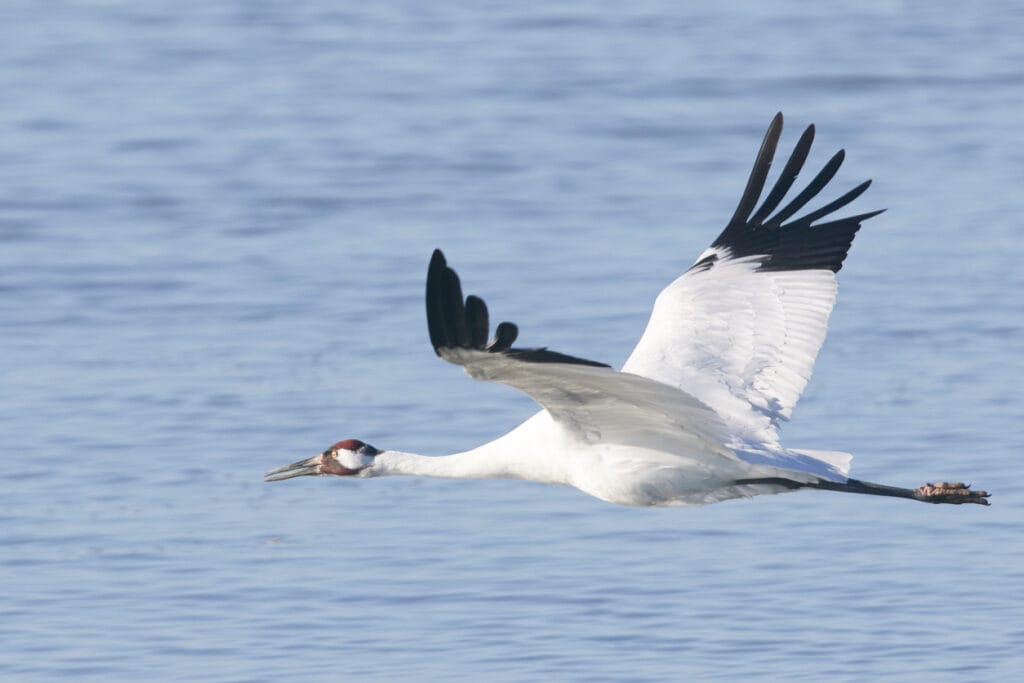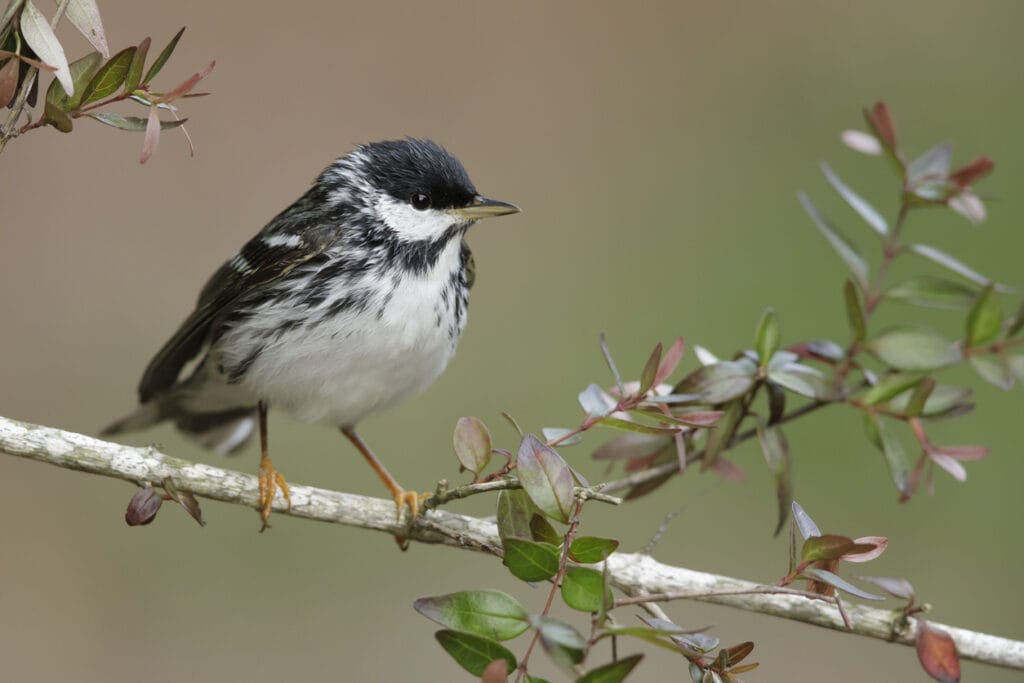With stunning vibrant colors and unique sounds, the Northeast is heaven for anyone who has a passion to explore various species of birds. In fact, in North America alone, there are more than 900 identified species of birds for you to watch! In today’s article, we’ll walk you through 7 rare birds of the Northeast that you should be on the lookout for.
Here are the top 7 rare birds of the northeast.
- Whooping Crane
- Kirtland’s Warbler
- Ivory-Billed Woodpecker
- Seaside Sparrow
- Piping Plover
- Loggerhead Shrike
- Willow Flycatcher
A lot of these bird species are available all across the north and it would be quite difficult to miss the chance of coming across one. However, there are some birds that you would consider really lucky if you get the chance to spot one, even with your binoculars!
Let’s go into more detail on each of the rare birds of the Northeast.
1. Whooping Crane – Grus Americana

Kicking off the list with one of the most unique and rare birds that you might come across while bird watching in the northeast region in the U.S.
The whooping crane is one of the tallest birds, if not the tallest, in North America, standing at anywhere between 4 ft 1 in. to 5 ft 3 in. It’s also quite heavy, weighing anywhere between 14 to 16 lbs.
However, it’s large stature doesn’t make finding one any less difficult. In fact, sandhill cranes and whooping cranes are the only species of cranes that inhabit North America.
You can identify an adult whooping crane by its large white body, long legs, red crown, as well as the pointed, long, and dark bill.
Author Note: They also have characteristic black wing tips that you can clearly see when they spread their wings to fly. The younger whooping cranes will have a brownish or reddish tinge to their white feathers.
As the name suggests, the whooping crane has a loud whooping call that makes it easier to follow and hunt the birds, which is why they’ve seen a huge decline in numbers although they have a relatively long lifespan of 22 to 24 in the wild.
The numbers of the whooping cranes plummeted to as low as 21 wild and 2 captive birds in 1941. This makes it one of the rare birds of the Northeast.
With conversation efforts, the numbers have grown slowly to reach about 505 wild cranes in 2017, according to the United States Fish and Wildlife Service.
2. Kirtland’s Warbler – Setophaga Kirtlandii

The Kirtland’s warbler was nearly extinct just over 50 years ago but the bird’s range has expanded significantly due to the efforts spent to recover the species. This makes it a rare bird of the Northeast.
You’d find the most luck spotting these birds in the state of Michigan, as they’re mostly found there. However, you can still spot some of them in popular breeding spots in neighboring states that have been recently discovered.
Kirtland’s warblers are also known among the locals in Michigan as the “jack pine bird” or “jack pine warbler”.
They have yellow bellies along with a bluish-grey upper body covered with dark streaks on the back as well as the sides and flanks.
In addition to habitat limitation, one of the problems that cause the bird’s population to decline is another bird called “the brown-headed cowbird”, which lay their eggs in the warbler’s nest and destroy their eggs as soon as the brown-headed cowbird youngs hatch.
3. Ivory-Billed Woodpecker – Campephilus Principalis

Woodpeckers are found in abundance in the Northeast. Species like the pileated woodpeckers and red-headed woodpeckers are known to be the most common ones there.
Yet, if you’re looking for the rarest woodpecker to spot, the ivory-billed woodpecker would give you a seriously tough but rewarding challenge.
The ivory-billed woodpecker is among the largest woodpecker species in the world the largest that you can find in the United States. It has a length of 18.1 to 20.1 inches with a wingspan that reaches up to 31.5 inches.
In addition to the size, the ivory-billed woodpecker has a unique coat of purplish dark feathers that makes it easy to distinguish from other strains of large woodpeckers.
According to the IUCN Red List, the bird is critically endangered, although some naturalists and bird experts believe that the woodpecker is actually already extinct.
4. Seaside Sparrow – Ammodramus Maritimus

If you’re in the state of Massachusetts, you’ll have the most luck spotting a unique sparrow that inhabits the Atlantic coast, the seaside sparrow.
Adult seaside sparrows have greyish-brown upper bodies along with streaks of grey on the nape and crown of the bird.
They have a distinct dark mask on their face with a whitish throat. Their chirping calls highly resemble those of the red-winged blackbirds despite the striking differences in their looks.
Author Note: The seaside sparrow exists in different subspecies depending on the region they live in. In fact, some of these subspecies have been extinct since the late ’80s, such as the dusky seaside sparrow.
Unfortunately, the seaside sparrow is getting rarer every day because it’s prone to habitat loss due to natural disasters as well as habitat loss for beaches and resorts.
Another reason for their rarity is that they often migrate down south along the east coast looking for a more suitable habitat for living and foraging.
5. Piping Plover – Charadrius Melodus

The piping plover is another rare bird that is often difficult to spot due to its small size and how great it blends with its sandy beach habitat, especially when it’s standing still.
It has a large rounded head along with yellow-orange legs that are characteristic of other shorebirds. The bird measures an average of about 6.5 inches in length and weighs about 2 ounces.
The adult ones also have a black band that runs from eye to eye across the forehead along with a black stripe that goes along the breast line like a chain. It also has a stubby orange bill with a black tip.
A lot of conservational efforts are being spent to keep the population of the birds stable, which led to an increase in their numbers since 1999, reaching a total population of about 6,500+ birds.
The piping plover usually migrates to the south in the winter and they have a light and soft whistle-like call.
6. Loggerhead Shrike – Lanius Ludovicianus

There are two native shrike species in Northern America. However, the rarest of the two is the loggerhead shrike. This one is a medium-sized passerine that’s relatively smaller than the Northern shrike.
Yet, it has earned its name from having a relatively large head when compared to the size of the rest of its body.
These birds have grey breasts with white to pale gray plumage on their back. Their head is usually black with the dark feathers extending all the way to their bills. Additionally, they have black wings as well as a black tail.
The loggerhead shrike has an average length of about 3.85 inches and weighs anywhere between 45 to 60 grams.
Yet, you shouldn’t let the small size of the bird trick you! This one is also known as the “butcher bird” because it has some carnivorous tendencies.
They feed on small prays, such as lizards, baby mammals, and other small birds by impaling them on barbed wire and thorns before consuming them.
In the last few years, the numbers of loggerhead shrikes in the northeast and midwestern region have declined significantly, making it a bit of a rare occasion to spot one in the wild.
7. Willow Flycatcher – Empidonax Traillii

Last but not least, the willow flycatcher is one of the rare birds of the region not only because it migrates, but also because it competes with another bird from the flycatcher group over the same habitat, the alder flycatchers.
Not only that, but they look very much alike, which minimizes your chances of finding willow flycatchers easily. In fact, at one point in history, the two birds were considered a single type of flycatcher known as the “trail flycatcher”.
Author Note: The willow flycatcher, similar to other flycatchers in the region, prefers to spend the winter months in relatively warmer climates of the tropical countries, such as Guatemala, Venezuela, and Colombia.
Luckily, since they spend the breeding season in the Northeast region, you’ll also be able to spot them through their calls, which is also one of the easiest ways to tell them apart from other flycatchers.
The adult willow flycatchers have a brownish olive upper body with darkening on both the tail and the wings. The lower body is made up of white or off-white feathers along with white wing bars and a tiny bill.
Wrap Up
There you have it, a list of rare birds that you’d be very lucky if you come across during bird watching in the northeast.
As you can see, these birds have different reasons for their population to decline or even becoming on the verge of extinction.
Luckily, the protective measures and laws by the federal and state governments in these areas might help greatly in recovering the number of birds in these rare species.
If you spot one of these birds, make sure that you appreciate them from a distance without spooking them out.
Also, make sure that you report the sighting to the authorities, especially if the bird is in a bad condition and might need help.










